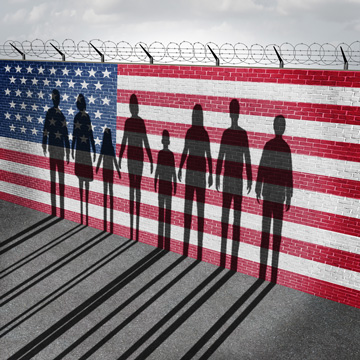War on Immigrants

President Donald Trump’s anti-immigrant vitriol and policies are predicated on a hyperterritorial worldview in which immigrants are cast as job stealers and criminals. His sweeping executive orders now set the stage for mass deportations, and show the most sudden and significant hardening of immigration policy in generations. Add to this mix the “Muslim Ban,” the attack on H-1B visa programs, and the construction of nativist border walls, and it appears that this U.S. administration is indeed waging a war on immigration.
A Sikh man working in a 24-hour grocery store in North Shore in the New York City borough of Staten Island cowered in the back of the store room, petrified. His heart raced as federal agents stormed the area rounding up illegal immigrants. The man, who didn’t want to be identified for fear of being targeted, said, “I couldn’t go back to India as I am the family breadwinner. America doesn’t care about splitting up poor families.”
Trump and his supporters have fermented a narrative that demonizes illegal immigrants as the only culprits in our nation’s massive systematic failure that is responsible for allowing the count of such immigrants to mushroom to 11 million. It’s a false narrative as highlighted in the editorial titled, “What Part of 'Illegal' Don’t You Understand?” (on page 10 in the print issue).

Under the Trump presidency, federal agents are planning to step up migrant deportation quotas at a rate of more than 1,000 a day, with little regard for the havoc caused to children torn apart from their parents.
Steeped in bigotry, racism, and xenophobia, the political climate fermented by Trump’s rhetoric has resulted in an alarming lack of compassion for the plight of people like Singh and their families who come to the U.S. to escape harsh economic realities. Under the Trump presidency federal agents are planning to step up migrant deportation quotas at a rate of more than 1,000 a day, with little regard for the havoc caused to children torn apart from their parents, and other family splits.
If we add to this mix the prevalence of abuse that deportees face from federal agents, the travel ban on people from six Muslim-majority countries, the onslaught on H-1B visa programs, and the rampant construction of nativist border walls, it begins to appear that the U.S.—known around the world as a shining beacon for immigrants—is indeed waging a war on immigration.
“MILITARY OPERATION”
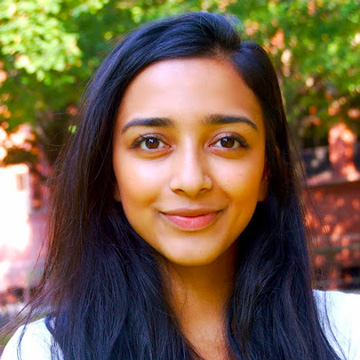
Tara Raghuveer (left), deputy director of the National Partnership of New Americans (NPNA), a coalition of 37 immigrant and refugee rights: “Over the past several weeks the Trump administration has waged a war on immigrants, refugees, Muslims, and brown communities.”
“Over the past several weeks the Trump administration has waged a war on immigrants, refugees, Muslims, and brown communities,” said Tara Raghuveer, deputy director of the National Partnership of New Americans (NPNA), a coalition of 37 immigrant and refugee rights groups. “A lot of folks are terrified,” added Raghuveer. Federal agents have stormed homes in New York, Atlanta, Austin, Chicago, Los Angeles, and other cities rounding up undocumented immigrants. Immigration and Customs Enforcement (ICE) agents have just stepped up deportation raids in at least 11 states during Operation Cross Check.
President Trump called his drive to ramp up deportations a “military operation.” “We’re getting really bad dudes out of this country, and at a rate that nobody’s ever seen before,” Trump told business leaders at the White House on February 24. “And they’re the bad ones. And it’s a military operation.”
The U.S. military, however, is not involved. The new enforcement policies require law enforcement agencies to hire thousands of new agents to find, arrest, and deport “illegal” immigrants—regardless of whether they crossed over the border illegally or simply find themselves out of status due to minor paperwork infractions or imperfections. Along with ICE, local police departments have been asked to round up such so-called illegal immigrants.
BROWN “ILLEGALS” BECOME “BAD HOMBRES”
Under the Obama administration, roughly 1.4 million
people were considered “priorities” for deportation.
They included recent arrivals, and people with multiple
criminal violations.
However, Trump’s new enforcement policies widen the net, stripping away restrictions on who should be deported. Up to 8 million people in the country illegally could be considered priorities for deportation, according to calculations by the Los Angeles Times.
Alarmingly, Indians are the fastest growing illegal population in the U.S. In 2014, there were nearly half a million unauthorized Indian immigrants representing a 43 percent spike since 2009, when the number was 350,000, according to a recent Pew Research Center report. All of these 500,000, most of whom have overstayed their student, business, or tourist visas, now run the risk of being deported.
For the most part, the 3.1 million-strong Indian American community with more than 200,000 millionaires has thrived with fancy college degrees and above-average incomes. However, nearly 500,000 Indians are living in America illegally. Under the new directives, they could be considered a priority for deportation. “Since these Indians are illegal, they work in small familyowned restaurants, motels, businesses, store fronts, gas stations, and delis,” said immigrantrights lawyer Mukul Chand. “They’ve worked unimaginably hard in America, some for over a decade, and they now risk losing everything!”
“ICE will not only round up ‘bad hombres,’ they are going after Indians, South Asians, Africans, anyone really they can catch who has entered the U.S. without passing through an official border or overstayed their visas,” said Chand. “Everyone who is here illegally could potentially be considered a priority.”
DEPORTER-IN-CHIEF
Trump is being criticized heavily by immigrant-rights
groups as the “Deporter-in-chief.” They say
his overzealous “military” deportation push could result
in families being split apart and violations of due-4process
rights.
As highlighted in the editorial referenced earlier, these folks may bear some responsibility for their illegal status, but certainly they couldn’t have worked, lived, gone to schools and colleges, paid taxes, and more, for years and even decades, if the host nation was not complicit in the act. America harbored, aided, and abided millions of illegal immigrants—creating a precedent of sanctioning this practice, even if only implicitly.
Hence the ill-conceived agenda of the Trump camp to now drive them out unceremoniously is an ugly subversion of American values. Activists have staged protests and are broadcasting “Know Your Rights” public service announcements over the radio in poor immigrant neighborhoods as people fear that ICE agents could resort to racial profiling techniques to round up undocumented people. “We will demand that our representatives in Congress support our nation’s compassionate resettlement of refugees fleeing persecution, and end the cruel and unnecessary deportations destroying immigrant families,” said Harvardeducated Raghuveer, who turned down a job with a hedge fund to be a champion for immigrants.
The American Civil Liberties Union (ACLU) said it would challenge Trump’s executive orders and Homeland Security Department memos. “These memos confirm that the Trump administration is willing to trample on due process, human decency, the well-being of our communities, and even protections for vulnerable children, in pursuit of a hyper-aggressive mass deportation policy,” said Omar Jadwat, director of the ACLU’s Immigrants’ Rights Project.
“Trump’s mass deportation policy takes aim at people who go to work every day. They are not criminals. This will end up gutting businesses that rely on immigrant labor. It will split up families in the cruelest way,” said immigrant rights activist Bhibu Mohanty.
“GO BACK TO YOUR OWN COUNTRY”
Since Trump’s election, hardly a day goes by without
reports of hate violence targeting Muslims, Arabs,
Sikhs, South Asians, African Americans, Jews, and Latinos.
There is no question that Trump’s victory has
brought the bigots out of the woodwork. In all, the
Southern Poverty Law Center has documented a record
900 hate crimes since the November election of Trump.
Trump says he loves Hindus, but the ground reality is that Indians, a majority of whom are Hindus, are among the most vulnerable groups in the United States. In February, white nationalist Adam W. Purinton yelled “get out of my country” at two 32-year-old Indian men—Srinivas Kuchibhotla and Alok Madasani—before he opened fire at Austins Bar and Grill in a Kansas City suburb. He shot to death computer engineer Srinivas Kuchibhotla, while injuring his friend and also wounding a white American who tried to stop the gunman.
Then in March, a masked gunman opened fire on Deep Rai, a 39-year-old Sikh man in the driveway of his home in a Seattle suburb in Kent, after yelling “Go back to your own country.” Rai is expected to recover.
AMERICAN DREAM SLIPPING
Under attack because of their identity, Indians
are seeing the American Dream slipping away. “I always
wondered how safe it was to stay in the United
States of America, but my husband always assured
me that only good things happen to good people,”
Srinivas Kuchibhotla’s grief stricken wife Sunayana
Dumala told reporters. “He did not deserve a death
like this.”
A few days after the killing, Dumala described how her husband, a young engineer from Hyderabad, had come to the U.S. believing America had unlimited opportunities. “We just had to go work for it. Most of us had the feeling we could go do anything we wanted in this country if we tried and wanted it bad enough,” said Dumala. The young woman described the shattering of her American Dream in a blogpost on Facebook. “We built our dream home, which he painted, and installed the garage door,” wrote Dumala. “It’s so unfortunate that this dream of ours is now shattered.”
The shootings are part of a larger pattern. However, the White House, speaking about the Kansas shooting, said any loss of life is tragic, but described it as absurd to chalk it up to Trump’s rhetoric. The relatives of the Indian men beg to differ. They say the shootings are connected to a climate of xenophobia and hostility against those seen as different and foreign to the White supremacist.
Dumala, in the same Facebook post describing her shattered American Dream, asks the question which plagues most Indian Americans, especially those who have immigrated to the United States as adults: “Do we belong? Is this the same country we dreamed of and is it still secure to raise our families and children here?”
TIME TO STEP OUT OF THE “MODEL MINORITY” COCOON
For too long, Indian Americans have burnished
the “model minority” label, and worn it like a badge of
honor, believing somehow that they are immune to
racism. As successful doctors, scientists, professors,
and techies, they live in a bubble: comfortable, middle-class,
white neighborhoods with manicured lawns.
They are more focused on getting their kids into Ivy
League schools than registering unpleasant experiences
of racism.
“Your present life may be completely encased in the bubble and you may choose to seal yourself off from the realities of the world,” said author Pooja Makhijani, who grew up in a predominantly white neighborhood in New York. In the introduction to her hugely popular first book Under Her Skin: How Girls Experience Race in America, Makhijani confessed to suffering a fleeting “I-refuse-to-be-Indian-why-can’t-you-see-that-I-am-as-white-as-you” phase. In one of her candid essays, Makhijani recalls a childhood spent swapping the traditional Indian lunches her mother packed for the processed school lunches other “luckier” kids bought.
As quoted in crossroadstoday. com, Gurjot Singh, 39, who served in the Marine Corps and is an Iraq War veteran, said he was dismayed that people think others who look different aren’t equal or don’t contribute equally to the community. “This is equally my country as it is your country,” Singh said after the Seattle suburb shooting of the Sikh man. “It doesn’t anger me. It hurts me.”
In undiscerning eyes, the turban has somehow been terribly mixed up with Osama bin Laden’s headgear. In August 2012, white supremacist Wade Michael Page strode into the Wisconsin gurdwara brandishing a handgun and killed six Sikhs. Despite America’s efforts at being a pluralistic society, the Sikh Coalition says 60 percent of turban-wearing boys are harassed in schools and the bullying has become worse after the elections.

Sixty percent of turban-wearing boys are harassed in schools and the bullying has become worse after the elections. Even high-profile Sikhs like Sonny Caberwal, who was part of the highly visible Kenneth Cole ad campaign celebrating “Non-Uniform Thinkers,” are not immune from such hate.
“If you’re different, people can be mean,” entrepreneur and model Sonny Caberwal, who wears a turban and beard, once told reporters. Caberwal was part of the highly visible Kenneth Cole ad campaign celebrating “Non-Uniform Thinkers.” “It doesn’t matter if you’re black or Hispanic in a different part of town, you can hear things that are hurtful. They’ll say things that are not fair. I’ve certainly faced that in my time. When you look really different, it can happen to you with a much higher degree of frequency,” added Caberwal.
There’s little doubt that Trump has fueled anger against minorities and people who look different. The Salon called out the president for not taking responsibility for the hate crimes that are growing like kudzu. “Here’s a plain and uncomfortable fact: Adam Purinton and others like him are doing nothing more than following through on the spirit and words of Donald Trump’s xenophobia, nativism, and racism.”
THE PLIGHT OF H-1B PROFESSIONALS: “NOWHERE” MEN
AND WOMEN
It’s not easy to be an immigrant working on an
H-1B visa in the United States. It’s likely to get a lot
worse under Trump’s presidency.
On the campaign trail, Trump promised to raise the wages for H-1B workers so that Americans would be hired instead of cheaper coders from India. Then he issued a statement on his website, saying he wanted to scrap the visas altogether. A draft executive order that leaked in January directed administration officials to “restore the integrity” of the system and prioritize and protect the “jobs, wages, and well-being of United States workers.”
Companies can send in applications for the new batch of 85,000 H-1B visas on April 1. However, Press Secretary Sean Spicer sent alarm bells ringing on March 8 by saying the President would take a “comprehensive look” at all temporary work visas. “I think there is the legal part of immigration and then the illegal part of immigration. The President’s actions that he’s taken in terms of his executive orders and other revamping of immigration policy have focused on our border security,” Spicer told reporters at a press briefing. “And then, obviously, whether it’s H-1B visas or the other one—spousal visas—other areas of student visas, I think there is a natural desire to have a full look, a comprehensive look at that,” said Spicer.
U.S. companies for years have called on Congress to increase the cap on visas for high-skilled foreign workers. Last year demand for H-1B visas was so high that it surpassed the entire year’s allocation within five days. The government resorted to a lottery to pick H-1B visa winners.

Rishi Bhilawadikar (left), a user experience designer at a San Francisco e-commerce company, was inspired to make a movie, For Here Or To Go?, on America’s ‘dehumanized’ immigration system.
H-1B visa problems are so ubiquitous that Rishi Bhilawadikar, a user experience designer at a San Francisco e-commerce company, has made a movie, For Here Or To Go?, on America’s ‘dehumanized’ immigration system. Can I fulfill my dreams in the U.S.? Am I better off here? Will I even be allowed to stay here? Or should—or will I have to—return home? It’s a series of questions that Bhilawadikar says he and hundreds of thousands like him who are currently in some stage of the H-1B visa process ask themselves every day.
Thousands of Indian engineers who lend their computing genius to companies like Apple and Google and help launch successful start-ups in Silicon Valley live surreal lives dominated by the vagaries of the H-1B visa. “The problem for immigrants like me is that there’s no authentic legal or media or political representation. We are pretty much temporary visitors, and we are treated as temporary visitors for a very, very long time, to the tune of 15 or 20 years or so,” said Bhilawadikar, the Indian techie whose moving film on immigration is taking the festival circuit by storm.
THE PLIGHT OF H-4 SPOUSES IS EVEN WORSE
Since 2015, spouses of H-1B visa holders waiting for green cards have been eligible to work in the U.S. on H-4 dependent visas, thanks to a rule introduced by President Obama. But now, a group called Save Jobs USA is challenging that rule in court, and the Trump administration is proposing a 60-day freeze in employment authorization for H-4 visa holders. Activists say they are worried as U.S. Attorney General Jeff Sessions had earlier attacked the H-4 rule as an exception that “hurts American workers.”
The majority of Indian spouses come to the U.S. on H-4 visas. Immigration Voice, a national nonprofit serving high-skilled immigrants, filed a motion this week to intervene in the case on behalf of thousands of its members currently working in the U.S. on H-4 visas.
Sudarshana Sengupta, a brilliant biomedical researcher who has published papers at Harvard University and the University of Chicago, was about to launch a start-up on developing cancer immunotherapy strategies. But now, she has to fight for her right to work in the United States. “During the course of my research career, I have worked at and published from notable academic institutions, like Harvard University, University of Chicago, and Boston University, investigating molecular biological aspects of diseases such as cancer and certain cardiovascular conditions,” said Sengupta, who is cited in the Immigration Voice petition. “I am currently involved in preclinical research developing effective strategies for cancer immunotherapy, and am on the verge of launching my own start-up in this field. However, if the H4-EAD is taken away, then I will be unable to launch my start-up,” said Sengupta, mother to a nine-year-old son who is a U.S. citizen.
Anuj Dhamija, who is also cited in the Immigration Voice petition, has been working legally in the U.S. since 2010 as a project manager for a Fortune 100 company. After a decades-long wait for a green card, he switched to the H4 EAD program as it allowed him to start his own home remodeling business. “I expected to create 10 new jobs in America in the construction industry. If this program ceases to exist, I will lose all my investment in the new business,” said Dhamija.
A LOSS FOR AMERICA’S STATUS IN HIGHER EDUCATION
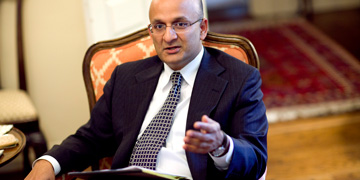
Nitin Nohria (left), dean of faculty at Harvard Business School warns of the decline in enrollments to American universities as a result of the “Muslim” ban. That could translate into a loss of $35 billion to U.S. universities.
The U.S. has enjoyed a coveted status as a leading destination for international students seeking higher education. Now, universities are worried that Trump’s decree could cause irreparable harm to U.S. higher education. Nitin Nohria, dean of faculty at Harvard Business School pointed out that the travel ban created “anxiety and confusion” among students about internships and career goals. “The dampening effects of the ban have become clear very quickly,” Nohria told Harvard Business School alumni. “Students (including a number with citizenship from the listed countries) are questioning their career prospects and wondering whether their families will be able to join them for Commencement. Faculty are debating whether they should travel to conduct their research and teaching. Class visitors are cancelling their trips, alumni are uncertain whether to return to campus for reunions, and we are concerned that our executive programs—which comprise two-thirds international participants—could see declines in enrollment,” added Nohria.
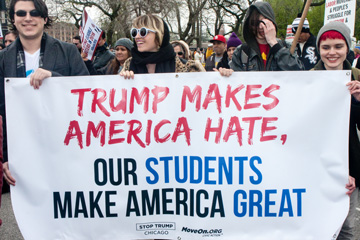
International students at U.S. colleges and universities surpassed one million for the first time during the 2015-16 academic year, according to the “Open Doors Report” published by the Institute of International Education (IIE). Theses international students spent $35 billion last year and U.S. schools have become increasingly dependent on that revenue.
“Nearly 40 percent of responding U.S. institutions are reporting a drop in international student applications…” showed initial findings from a survey of 250 schools conducted in February by six higher-education groups, including the Institute of International Education. “For educational institutions in the United States, the negative effects of the ban will extend far beyond 90 days and well beyond the six countries involved,” said Nancy Beane, president of the National Association for College Admissions Counseling which conducted the survey.
With Trump’s war on immigration, Canada is now a beacon for tolerance and inclusivity in North America, and many Indian students say they are looking for an opportunity to study in that environment. “Canada is an immigrant-friendly country. That’s what is most important to me,” said Ranjit Lal who has applied to do his Masters in engineering at McGill University. “I chose Canada over the U.S. because with Trump in the White House there are too many uncertainties about U.S. immigration policies,” said Lal.
In the 2014-2015 academic year, 263,000 international students were enrolled in Canadian institutions, drawn by Ottawa’s liberal post-college work permit, showed figures compiled by the Canadian Bureau of International Education. That number is likely to pop as Trump’s draconian immigration policies have boosted Canadian universities looking to recruit the best and brightest international students from around the world.
A LOSS FOR THE AMERICAN ECONOMY
The Center for American Progress estimates “a policy of mass deportation would immediately reduce the nation’s GDP by 1.4 percent, and ultimately by
2.6 percent, and reduce cumulative GDP over 10 years
by $4.7 trillion.” The Washington think tank said that
hard-hit industries would see double-digit reductions
in their workforces. “Unauthorized workers are
unevenly spread across industries, with the highest
concentrations employed in agriculture, construction,
and leisure and hospitality. Those three
industries would be hit hardest by a removal policy,
experiencing workforce reductions of 10 percent to 18
percent, or more. Other industries would also experience
reductions in output due to a mass deportation
policy,” wrote Ryan Edwards and Francesc Ortega in the
economic impact analysis published by the Center for
American Progress.
The Western Growers farming advocacy group said mass deportations would create a labor shortage with not enough immigrants in the U.S. to work the fields. “Believe me, those people who’ve been working for us have been invaluable for us to harvest our crops,” Tom Nassif, the president and CEO of Western Growers farming advocacy group told reporters. “If you shut down our ability to harvest our crops, you send more and more of our jobs to other countries. And that’s something I don’t think the president wants to see happen.”
There’s an attempt to paint immigrants as “criminals,” but most are law-abiding and scared to be on the wrong side of the law. “The reality is that once you take out immigration specific offenses, immigrants commit many fewer crimes, obviously, because these are often people who don’t want to draw attention to themselves,” said Andrew Selee, executive vice president of the Woodrow Wilson International Center for Scholars.
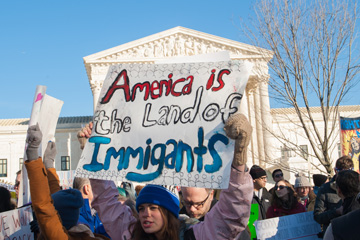
Trump’s war on immigration has an inverse relationship to making the country great: the more he succeeds in his agenda, the worse the country will fare. (Photo: Shutterstock)
A nation is made great not by slogans, but by its entrepreneurs, laborers, academics, and its institutions such as universities and hospitals. In each of these segments, immigrants have an outsized positive impact. Trump’s war on immigration has an inverse relationship to making the country great: the more he succeeds in his agenda, the worse the country will fare.
Uttara Choudhury is a contributor to The Wire and Forbes India. She has been covering American politics, foreign policy, diplomacy, and defense issues for two decades.
|
Immigration Ground Zero Attorneys MONICA KHANT and NISHA KARNANI give us an account of the devastating on-ground impact on day one of the Trump administration’s initial travel ban order. As representatives of the immigration legal community and nonprofits supporting immigrants and refugees, they were taken aback at the unconstitutional order and its haphazard roll out, particularly for those immigrants and refugees who have been persecuted, victimized, and/or settled in the U.S. On January 27, 2017, President Trump signed an Executive Order barring visa holders and refugees from seven nations. This sent a shockwave worldwide, creating panic and uncertainty for all immigrants and refugees. In Atlanta, we heard the next day that arriving refugees would be turned away, and we knew this could be a death sentence. Along with other immigration lawyers, some of us rushed to the Hartsfield Jackson Airport, unsure of what would await us on the front lines. What we encountered shocked us. Among the detained passengers was a 76-year-old mother with a stent and a 55-year-old diabetic woman needing access to medicine. A family of three, including a child, were possibly going to be denied entry into the U.S. Two men were held for “extreme vetting” and questioning before they were released hours later. All these individuals, among others being detained for hours, were green card holders who had jobs, families, homes, children, and grandchildren in the U.S.
Trump’s aggressive assault on illegal as well as legal immigration is an unprecedented and stunning reversal of America as the quintessential nation of immigrants. (Photo: Shutterstock)
Reasoning and advocating with U.S. Customs & Border Patrol did not get far, and so we called the press and our Congressman and worked with organizations to file a federal suit. These herculean tasks were juggled while managing the fears and concerns of the families left waiting in the terminal. Within hours, Congressmen John Lewis and Hank Johnson arrived and demanded answers, information, and release of these individuals, families, and mothers. When the release was not fast enough, Congressman Lewis urged us, “Why don’t we just sit down and stay awhile?” After two additional hours of waiting, families and loved ones were finally reunited. There’s no knowing the consequences if the immediate response of a rush to the airports and lawsuits had not taken place. That was just one day’s work. The legal community has since been inundated with cries for help from the immigrant population that is in a panic and uncertain of their future, no matter where they are from or what type of case they have. While this travel ban was halted by the courts, the administration has rolled out a new travel ban. Subsequent immigration executive orders and memos have cast an extremely wide deportation net. The community has since been anxiously trying to decipher fact from rumor on changes to the family-, humanitarian-, and employment-based immigration systems. Clearly, none of us has the luxury of sitting on the sidelines, whether we are specifically affected by a particular policy or not. The recent spike in hate crimes against South Asians and fellow minorities are devastating reminders of this. Most Americans do not support the views of anti-immigrants and white nationalists, neither do many of our Georgia politicians. But the loudest and most frequent calls they get are from these anti-immigrant and nationalist constituents. If we collectively and in solidarity decide to “sit down and stay awhile” with our minority communities, including our Muslim neighbors and friends, then we can make change.
What can we do? • Support financially or volunteer with the local Atlanta-based nonprofits that help immigrant clients. Organizations like Raksha, GAIN, SPLC, ACLU are just a few of the many that have tripled their workload due to these new orders and are responding hourly to the widespread fear. • Report hate crimes to the Southern Poverty Law Center (SPLC). • Consider running for office or supporting the political campaigns of candidates who understand your concerns and support your views. We have the power to speak up, educate, and effect change—and that is needed now more than ever. Monica Modi Khant is the Executive Director of the Georgia Asylum & Immigration Network (GAIN), a nonprofit that provides pro bono legal assistance to immigrant victims of human trafficking, domestic violence, and sexual assault, and asylum seekers. Nisha Karnani is an immigration lawyer and Partner at the firm Antonini & Cohen Immigration Law Group in Atlanta. |
Enjoyed reading Khabar magazine? Subscribe to Khabar and get a full digital copy of this Indian-American community magazine.
blog comments powered by Disqus




